The use of International Classification of Functioning, Disability and health Core Sets in a patient with lymphoedema in the upper extremity
Patient-reported outcome measures (PROMS) are becoming increasingly important in daily health care. The International Classification of Functioning, Disability and Health (ICF) Core Sets can be tools to support this development. This case report describes an intervention for a patient with lymphoedema after multiple erysipelas infections and the use of the ICF Core Sets for lymphoedema […]
What about us? The patient perspective
It’s clear that in order to gain an optimal outcome for the patient, we must first undertake a full assessment. Part of this involves an accurate differential diagnosis to ensure that the treatment is targeted and appropriately sequenced, directed towards the problem and the presented condition is the one that the professional is providing the […]
Lymphoedema education for a Breast Cancer Support Group: an overview of the programme and its delivery
This article summarises an education programme delivered to a breast cancer support group who had, or were at risk of, developing lymphoedema as a consequence of their treatment. The programme’s objectives of empowering the group members with education and self-management techniques to prevent and/or control lymphoedema are described in this article. Quantitative and qualitative feedback […]
Introducing the Leg Lymphedema Complexity Score
The Leg Lymphedema Complexity Score (LLCS) is a joint effort through the International Lymphedema and Wound Training Institute (ILWTI) and Nova Southeastern University (NSU) to create a tool to assist clinicians in identifying the various contributing factors and complexities of patients presenting with lymphoedema and skin impairments. The goal is to help drive proper examination […]
Indocyanine Green: our best option for lymphatic visualisation and our path to improved outcomes for patients?
Lymphoscintigraphy has been the benchmark for structural and functional lymphatic assessment of the deep lymphatic system (Narushima et al, 2016). We can derive quantitative and qualitative observations of the deep lymphatic system from it at specific regions of interest. However, its negatives are the relative ‘obscurity’ or lack of clarity of the images; it’s an […]
Exploring options for the conservative treatment of lymphoedema
Here, the editor answers a reader’s question and invites you to share your thoughts and experiences
Lymphoedema service provision across the UK: a national survey
Background: Lymphoedema services are known to be under-funded across the UK, but there is no research detailing the current service provision. Aim: To understand how lymphoedema services are funded and delivered across the UK and their level of resource. Methods: An electronic survey with 19 questions was sent out by email and undertaken by members of the British Lymphology Society […]
The lived experience of primary lymphoedema: a phenomenological study of personage and caregiver
Background: Paucity of interprofessional knowledge concerning primary lymphoedema (PL) heightens concerns that children with PL may receive incognisant care and that psychosocial and medical resources may be insufficient. Juxtaposing a young adult’s lived experience of PL with accounts from a medically-trained parent offers a new dimension to qualitative research. Aims: To translate and summarise the lived experience of […]
Ten top tips: preventing pressure ulcers under face masks
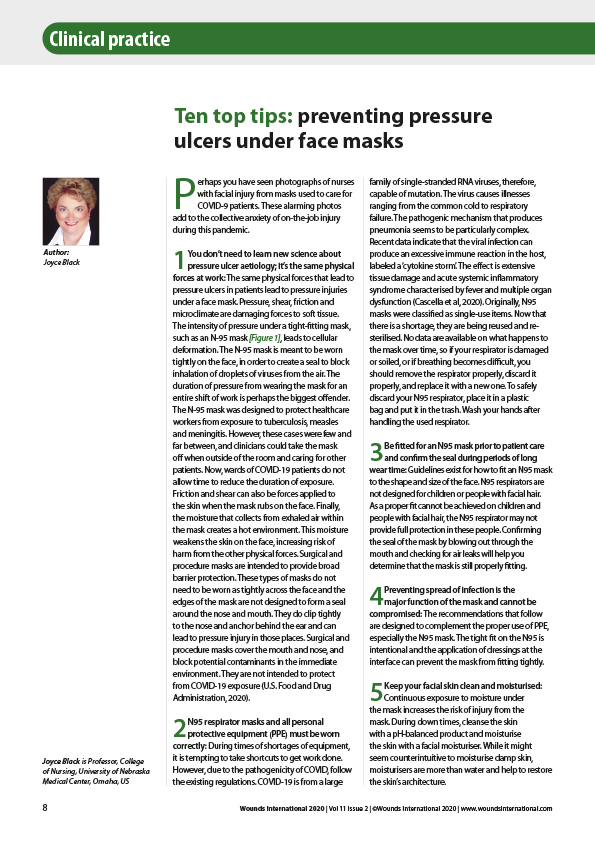
Perhaps you have seen photographs of nurses with facial injury from masks used to care for COVID-9 patients. These alarming photos add to the collective anxiety of on-the-job injury during this pandemic.
Minimising the risk for pressure ulcers in the operating room using a specialised low-profile alternating pressure overlay
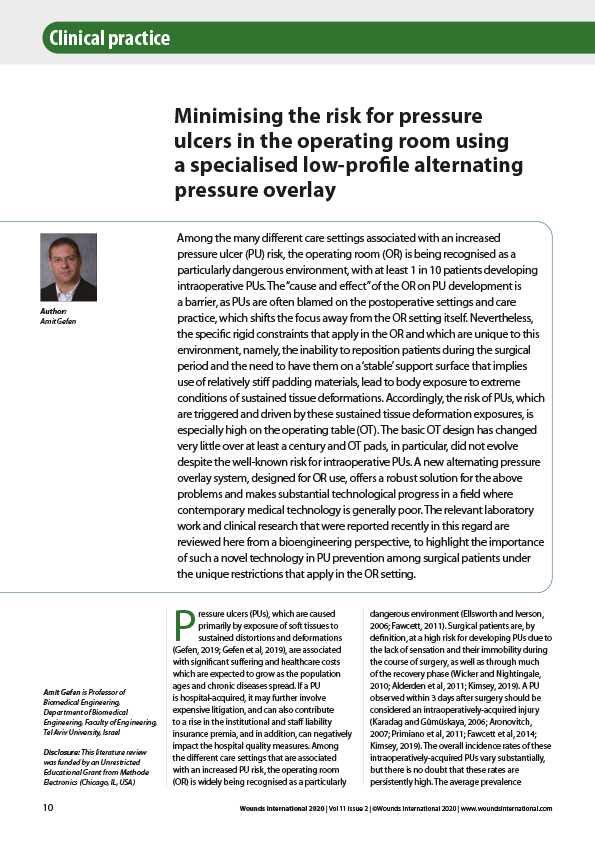
Among the many different care settings associated with an increased pressure ulcer (PU) risk, the operating room (OR) is being recognised as a particularly dangerous environment, with at least 1 in 10 patients developing intraoperative PUs. The “cause and effect” of the OR on PU development is a barrier, as PUs are often blamed on […]
Wound management in communities with limited resources: the mission and achievements of the World Alliance for Wound and Lymphedema Care

The World Alliance for Wound and Lymphedema Care (WAWLC) is an international health partnership of volunteers working to ensure individuals with chronic wounds and lymphoedema in resource-limited locations have access to optimal clinical care. This article outlines the WAWLC mission and objectives. It provides an update on some of the recent work completed by WAWLC […]
Reaching out for a higher level of knowledge and treatment of wounds: how to get there?
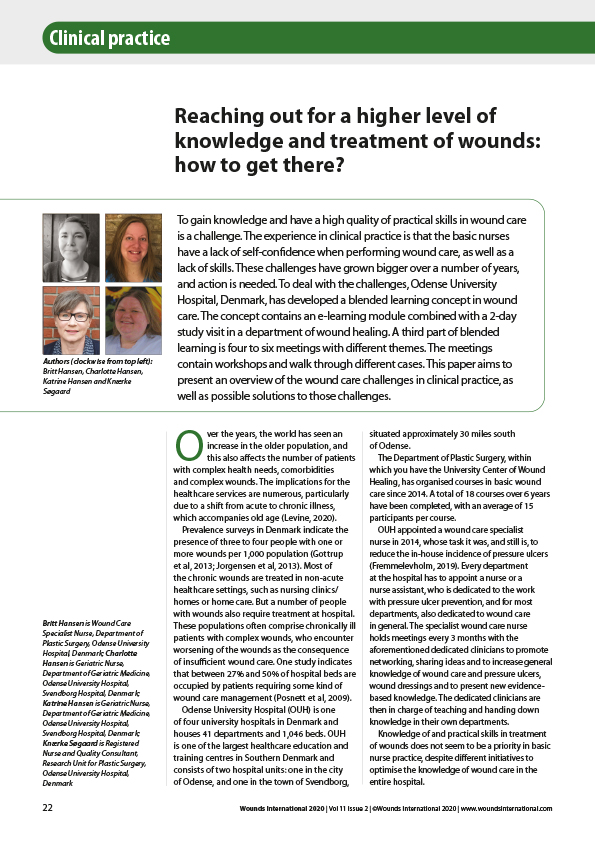
To gain knowledge and have a high quality of practical skills in wound care is a challenge. The experience in clinical practice is that the basic nurses have a lack of self-confidence when performing wound care, as well as a lack of skills. These challenges have grown bigger over a number of years, and action […]
Using Wounds Canada’s Pathway for Preventing and Managing Diabetic Foot Complications to guide decision-making
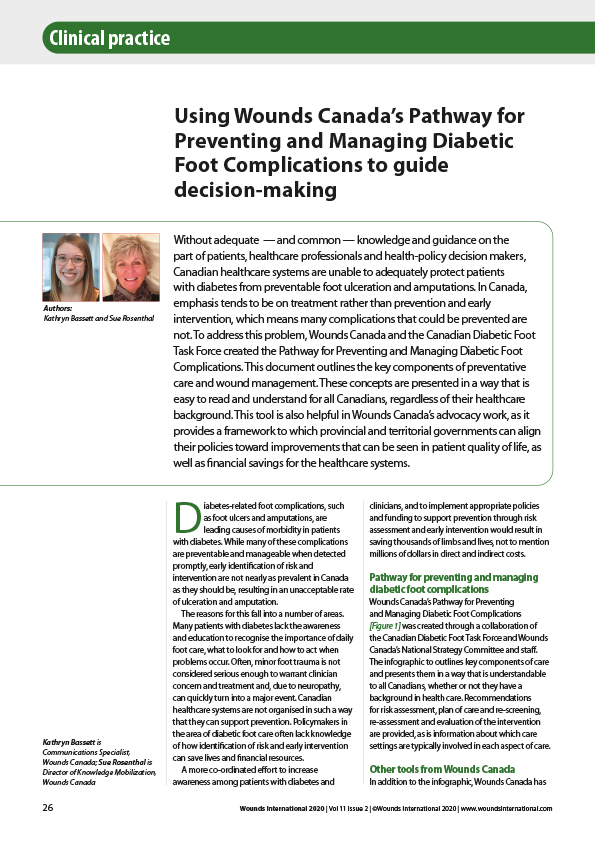
Without adequate — and common — knowledge and guidance on the part of patients, healthcare professionals and health-policy decision makers, Canadian healthcare systems are unable to adequately protect patients with diabetes from preventable foot ulceration and amputations. In Canada, emphasis tends to be on treatment rather than prevention and early intervention, which means many complications […]
Pathway to prevent pressure ulcers in the UK
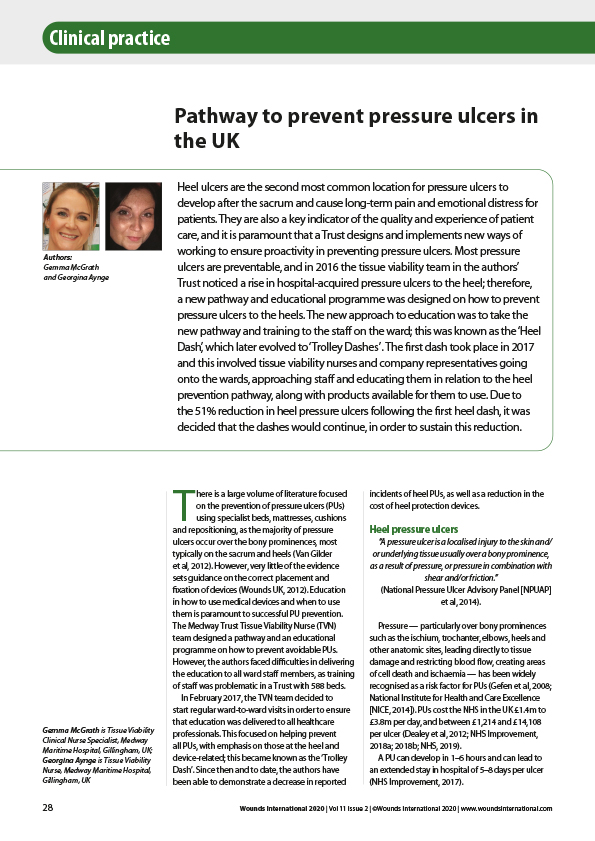
Heel ulcers are the second most common location for pressure ulcers to develop after the sacrum and cause long-term pain and emotional distress for patients. They are also a key indicator of the quality and experience of patient care, and it is paramount that a Trust designs and implements new ways of working to ensure […]
The use of mHealth technology for chronic disease management: the challenges and opportunities for practical application
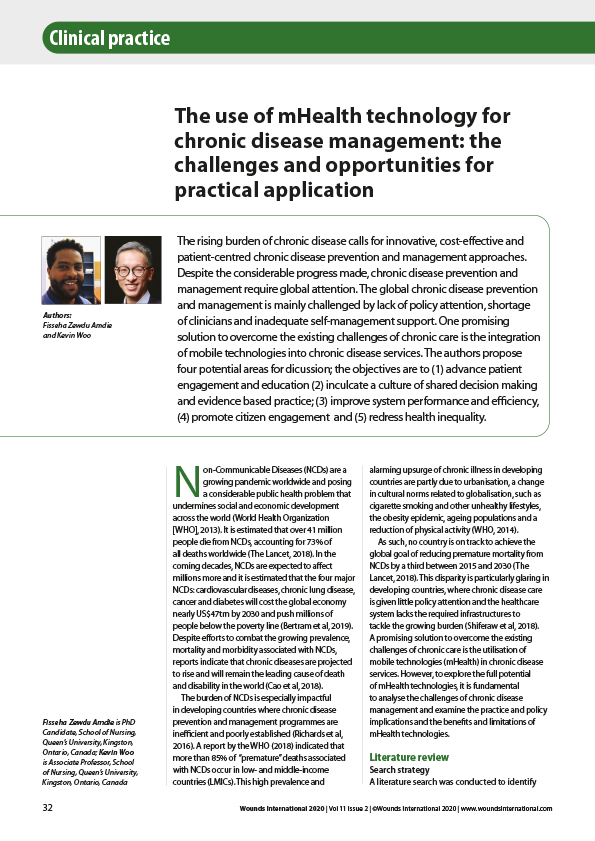
The rising burden of chronic disease calls for innovative, cost-effective and patient-centred chronic disease prevention and management approaches. Despite the considerable progress made, chronic disease prevention and management require global attention. The global chronic disease prevention and management is mainly challenged by lack of policy attention, shortage of clinicians and inadequate self-management support. One promising […]
Evaluation of a cyanoacrylate liquid skin protectant for the treatment of type 1 and 2 skin tears at a long-term care facility
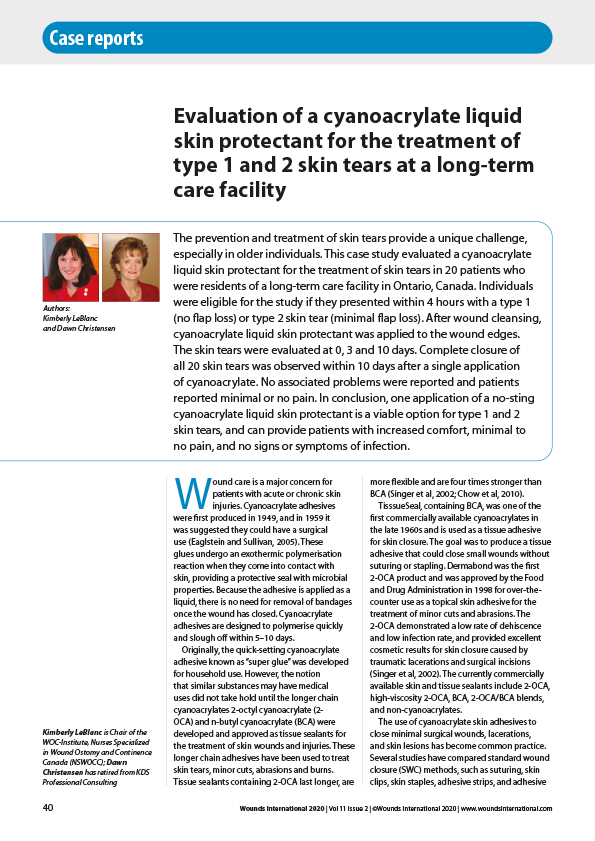
The prevention and treatment of skin tears provide a unique challenge, especially in older individuals. This case study evaluated a cyanoacrylate liquid skin protectant for the treatment of skin tears in 20 patients who were residents of a long-term care facility in Ontario, Canada. Individuals were eligible for the study if they presented within 4 […]
Managing dry wounds in clinical practice: challenges and solutions
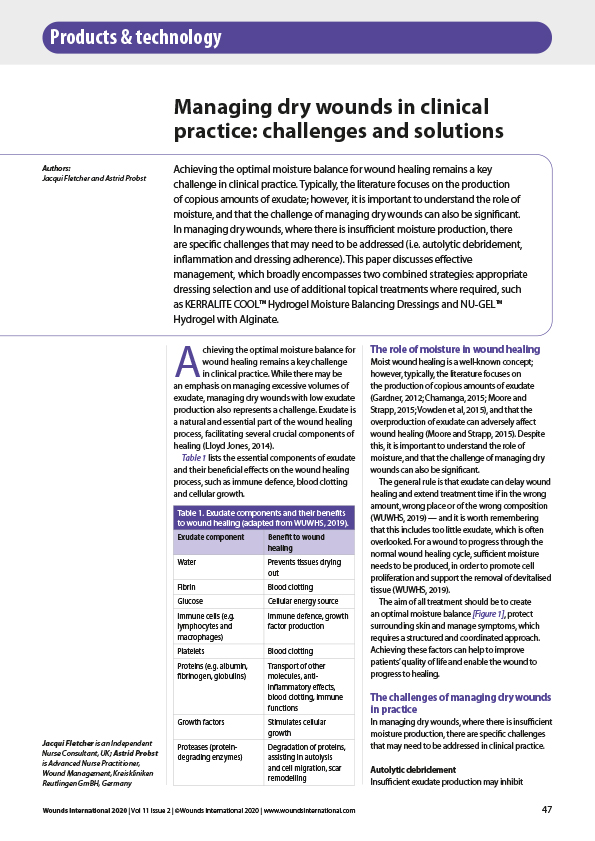
Achieving the optimal moisture balance for wound healing remains a key challenge in clinical practice. Typically, the literature focuses on the production of copious amounts of exudate; however, it is important to understand the role of moisture, and that the challenge of managing dry wounds can also be significant. In managing dry wounds, where there […]
Silver-containing foam dressings — does silver content matter?
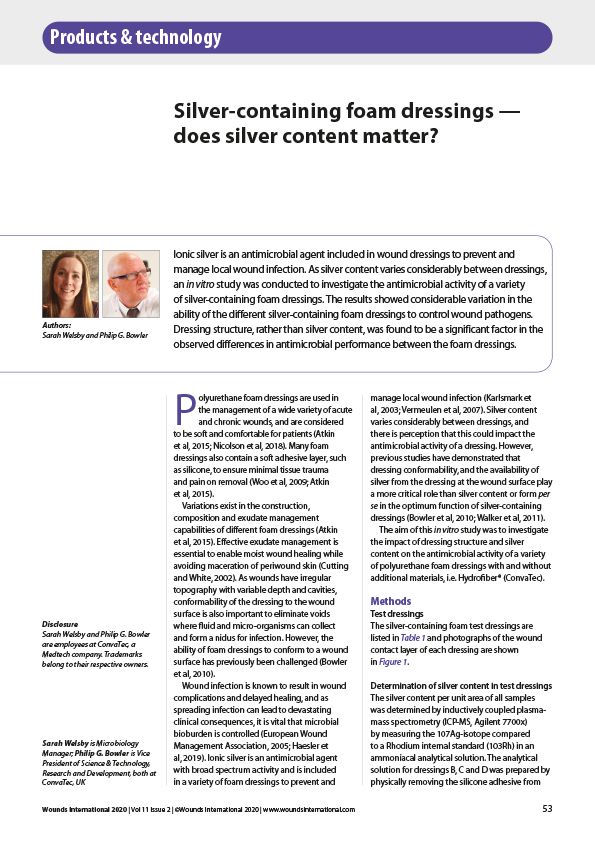
Ionic silver is an antimicrobial agent included in wound dressings to prevent and manage local wound infection. As silver content varies considerably between dressings, an in vitro study was conducted to investigate the antimicrobial activity of a variety of silver-containing foam dressings. The results showed considerable variation in the ability of the different silver-containing foam […]
Wounds digest
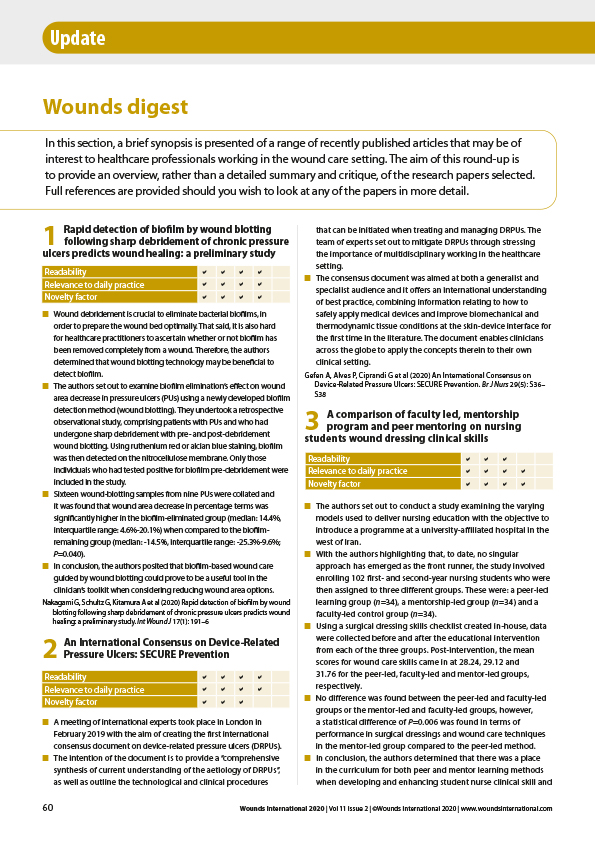
In this section, a brief synopsis is presented of a range of recently published articles that may be of interest to healthcare professionals working in the wound care setting. The aim of this round-up is to provide an overview, rather than a detailed summary and critique, of the research papers selected. Full references are provided […]
The new normal
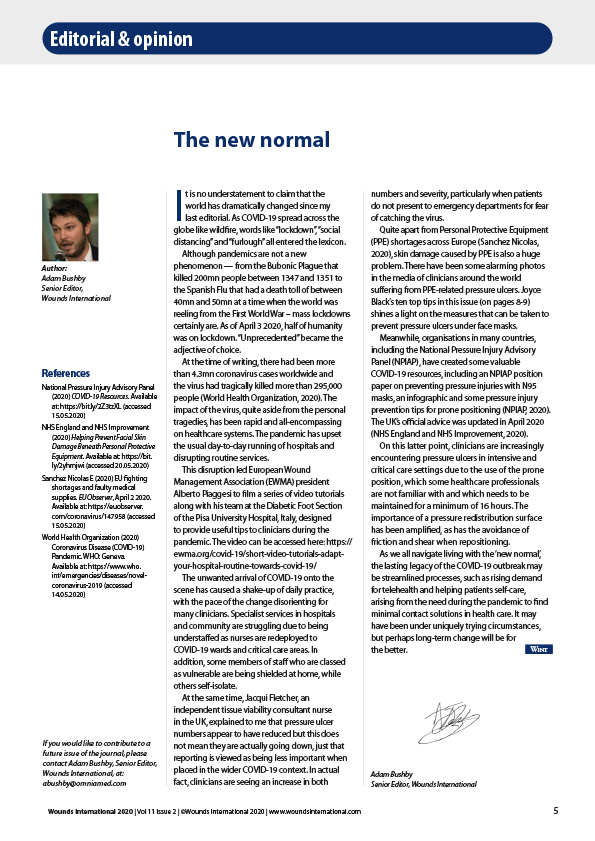
It is no understatement to claim that the world has dramatically changed since my last editorial. As COVID-19 spread across the globe like wildfire, words like “lockdown”, “social distancing” and “furlough” all entered the lexicon. Although pandemics are not a new phenomenon — from the Bubonic Plague that killed 200mn people between 1347 and 1351 […]
COVID-19 and wound care in the US
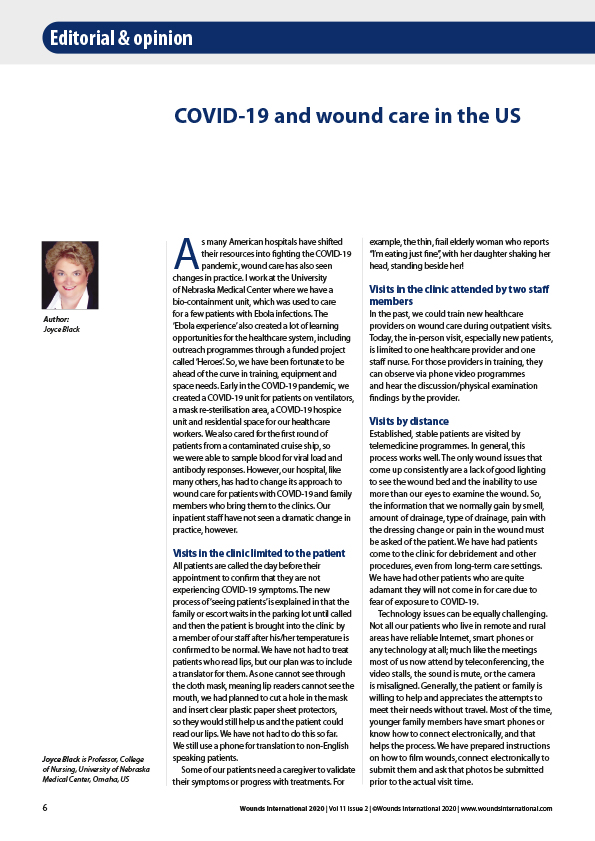
As many American hospitals have shifted their resources into fighting the COVID-19 pandemic, wound care has also seen changes in practice. I work at the University of Nebraska Medical Center where we have a bio-containment unit, which was used to care for a few patients with Ebola infections. The ‘Ebola experience’ also created a lot […]
International Best Practice recommendations for the early indentification and prevention of Surgical Wound Complications
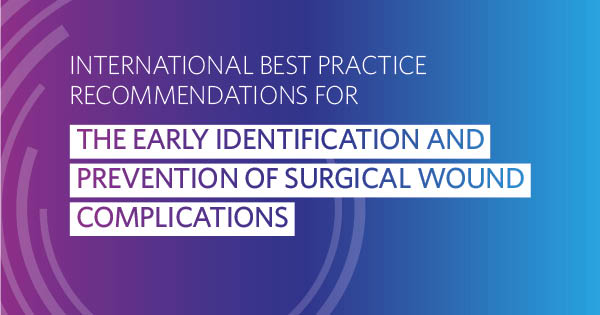
It is estimated that surgical wound complications (SWCs) are one of the leading global causes of morbidity following surgery, with mortality affecting 1–4% of patients following gastrointestinal surgery (Pearse et al, 2012; Collaborative GS, 2017). The Lancet Commission on Global Surgery estimates over half of the 4.2 million post-operative deaths each year occur in low- […]
Watch the launch of the ISWCAP BPS on the early identification and prevention of surgical wound complications
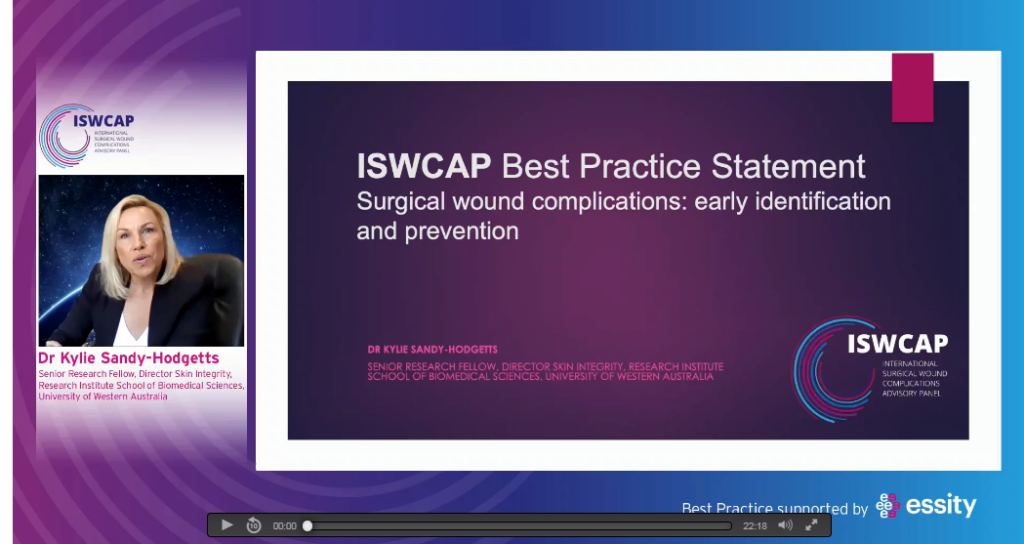
Watch the Presedent of the International Expert Workg Grop Kylie Sandy-Hodgetts (President ISWCAP), discuss the NEW International Best Practice recomendations for the early identification and prevention of surgical wound complications.
Best Practice Recommendations for holistic strategies to promote and maintain skin integrity
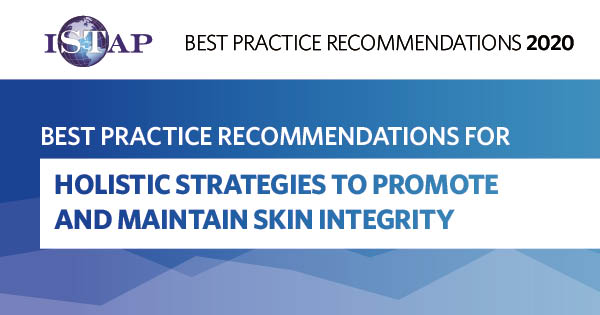
The skin is the largest organ of the human body. The functions of the skin are to protect us from external insults and to maintain internal homeostasis. During an individual’s lifespan, there may be periods of enhanced skin vulnerability, which render the individual more prone to the development of skin problems. Critical phases are very […]
Going against the pain
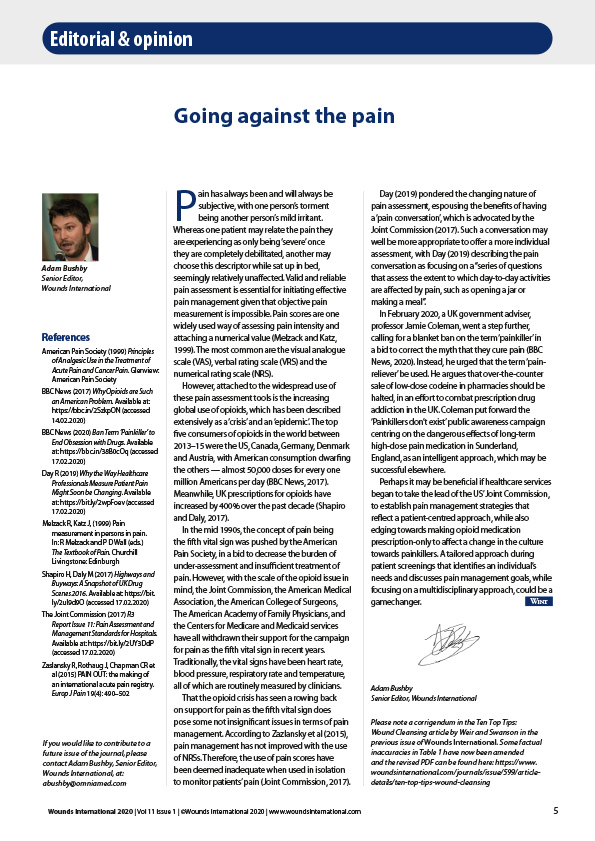
Pain has always been and will always be subjective, with one person’s torment being another person’s mild irritant. Whereas one patient may relate the pain they are experiencing as only being ‘severe’ once they are completely debilitated, another may choose this descriptor while sat up in bed, seemingly relatively unaffected. Valid and reliable pain assessment […]
Seeing what lies beneath the surface
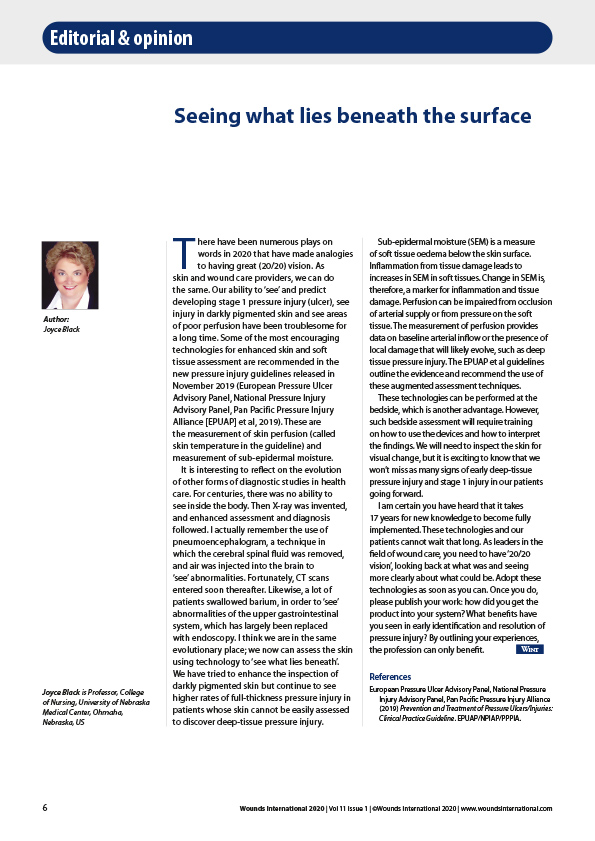
There have been numerous plays on words in 2020 that have made analogies to having great (20/20) vision. As skin and wound care providers, we can do the same. Our ability to ‘see’ and predict developing stage 1 pressure injury (ulcer), see injury in darkly pigmented skin and see areas of poor perfusion have been […]
Ten top tips: writing a conference abstract
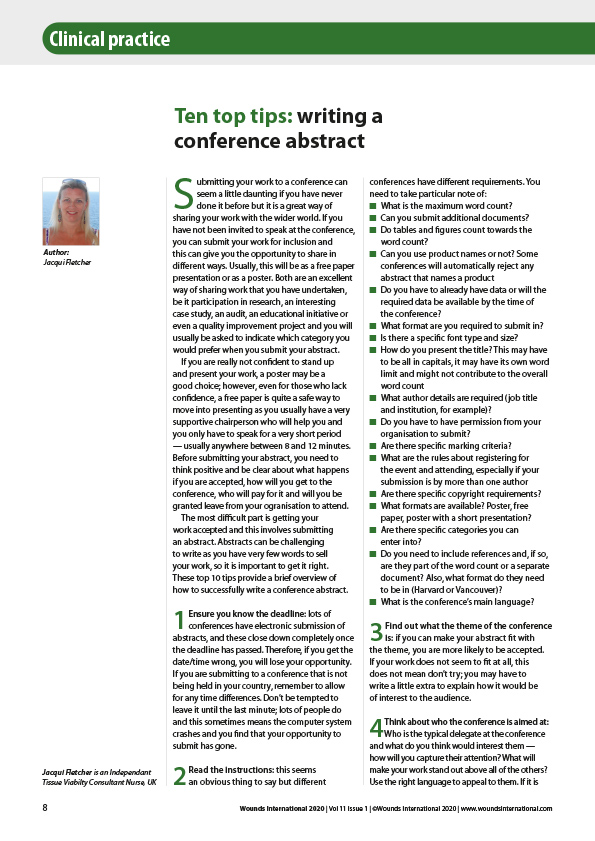
Submitting your work to a conference can seem a little daunting if you have never done it before but it is a great way of sharing your work with the wider world. If you have not been invited to speak at the conference, you can submit your work for inclusion and this can give you […]
Effect of mattress deployment on pressure ulcer development: a realworld observational cohort experience
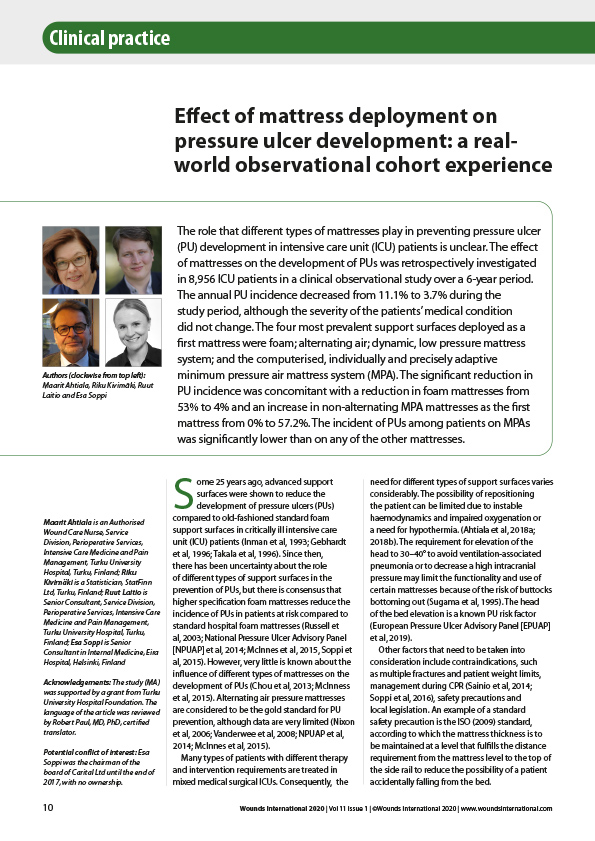
The role that different types of mattresses play in preventing pressure ulcer (PU) development in intensive care unit (ICU) patients is unclear. The effect of mattresses on the development of PUs was retrospectively investigated in 8,956 ICU patients in a clinical observational study over a 6-year period. The annual PU incidence decreased from 11.1% to […]
Repositioning for pressure ulcer prevention in the seated individual
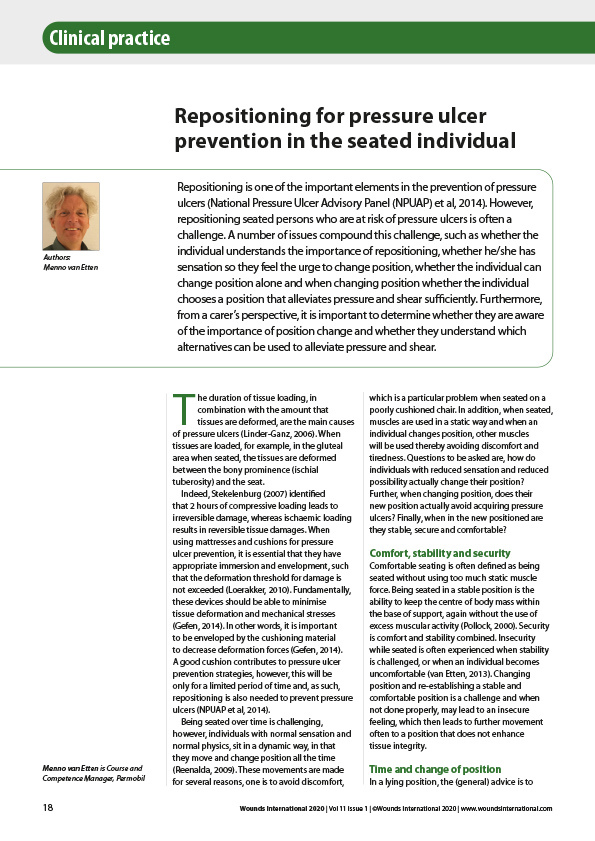
Repositioning is one of the important elements in the prevention of pressure ulcers (National Pressure Ulcer Advisory Panel (NPUAP) et al, 2014). However, repositioning seated persons who are at risk of pressure ulcers is often a challenge. A number of issues compound this challenge, such as whether the individual understands the importance of repositioning, whether […]
Modelling the cost-benefits arising from technology-aided early detection of pressure ulcers
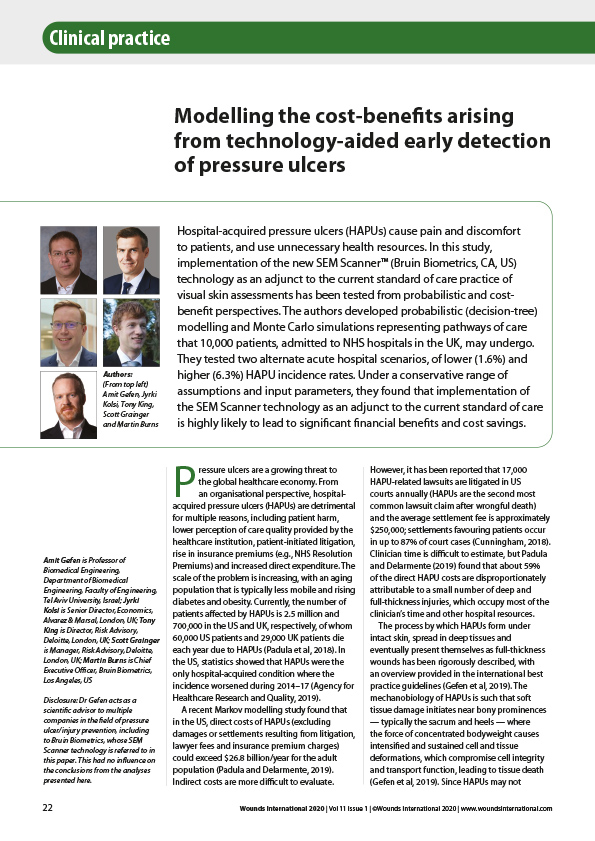
Hospital-acquired pressure ulcers (HAPUs) cause pain and discomfort to patients, and use unnecessary health resources. In this study, implementation of the new SEM Scanner™ (Bruin Biometrics, CA, US) technology as an adjunct to the current standard of care practice of visual skin assessments has been tested from probabilistic and costbenefit perspectives. The authors developed probabilistic […]
A clinical guide to pelvic skin assessment
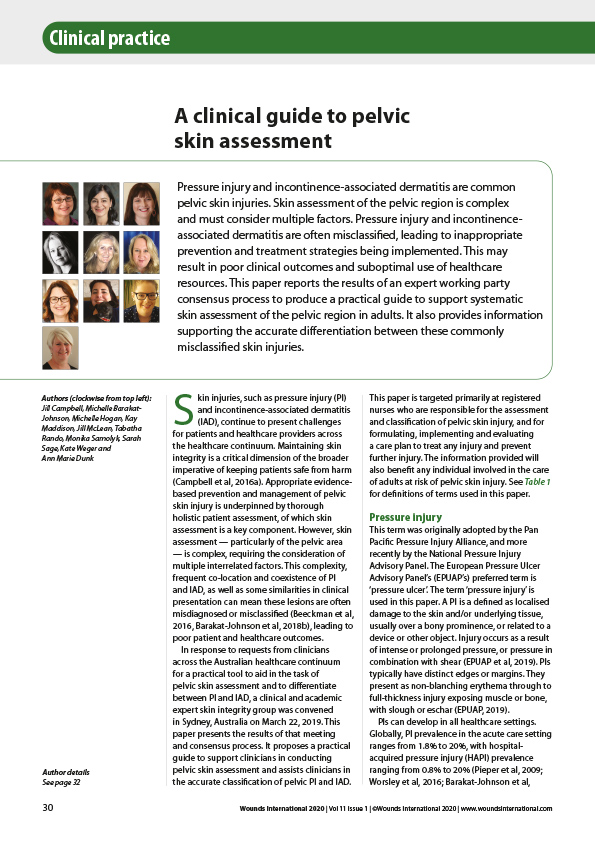
Pressure injury and incontinence-associated dermatitis are common pelvic skin injuries. Skin assessment of the pelvic region is complex and must consider multiple factors. Pressure injury and incontinenceassociated dermatitis are often misclassified, leading to inappropriate prevention and treatment strategies being implemented. This may result in poor clinical outcomes and suboptimal use of healthcare resources. This paper […]
Importance early and differential diagnosis in patients with chronic ulcers of the lower limb
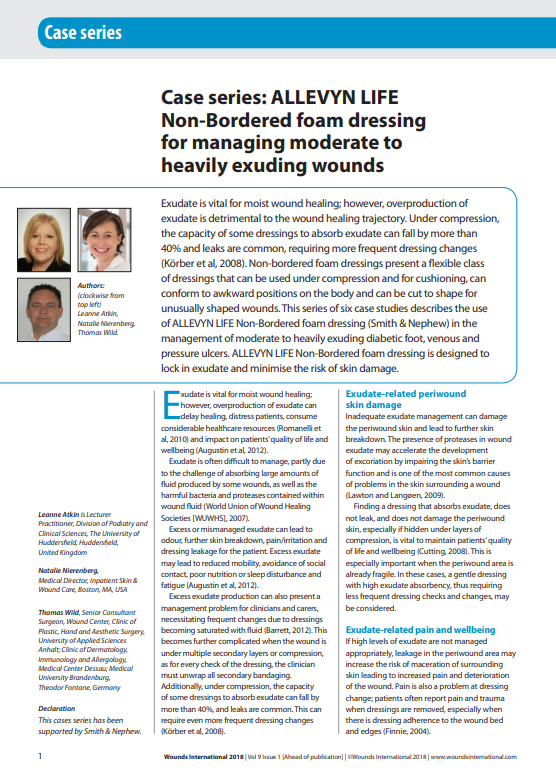
This case study provides an overview of a female patient who presented with ulcers in both lower limbs. Initially, she was diagnosed with arterial disease secondary to occlusion bilateral tibial, due to their multiple infectious intercurrences. This was further compounded by poor evolution to medical vascular treatment without the possibility of surgical treatment, due to […]
Wound management of surgical site infection post myelomeningocele repair
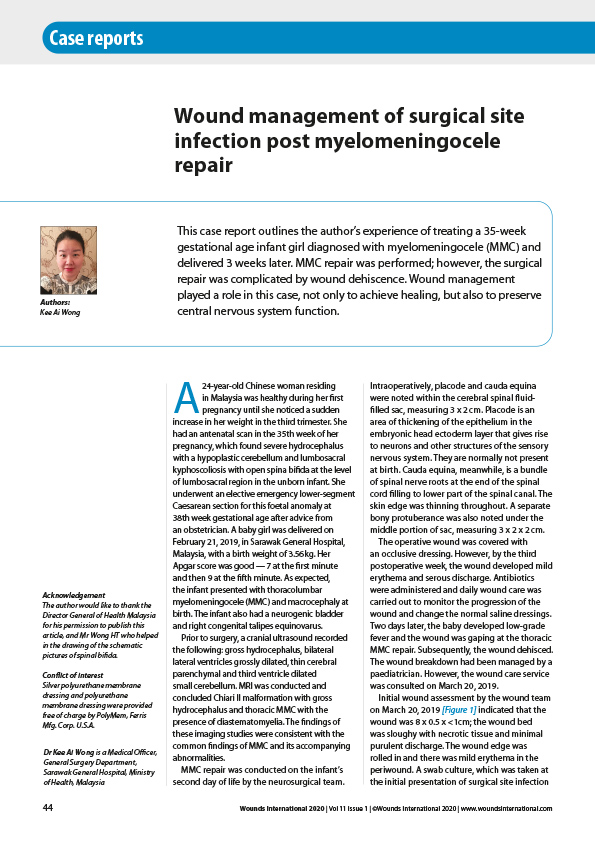
This case report outlines the author’s experience of treating a 35-week gestational age infant girl diagnosed with myelomeningocele (MMC) and delivered 3 weeks later. MMC repair was performed; however, the surgical repair was complicated by wound dehiscence. Wound management played a role in this case, not only to achieve healing, but also to preserve central […]
Findings from an expert panel meeting on NATROX® Oxygen Wound Therapy
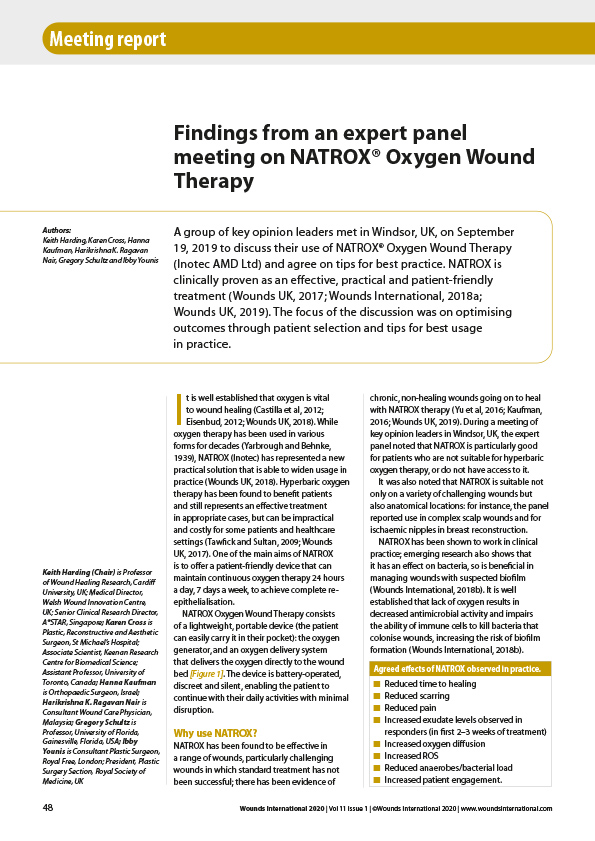
A group of key opinion leaders met in Windsor, UK, on September 19, 2019 to discuss their use of NATROX® Oxygen Wound Therapy (Inotec AMD Ltd) and agree on tips for best practice. NATROX is clinically proven as an effective, practical and patient-friendly treatment (Wounds UK, 2017; Wounds International, 2018a; Wounds UK, 2019). The focus […]
Wounds digest
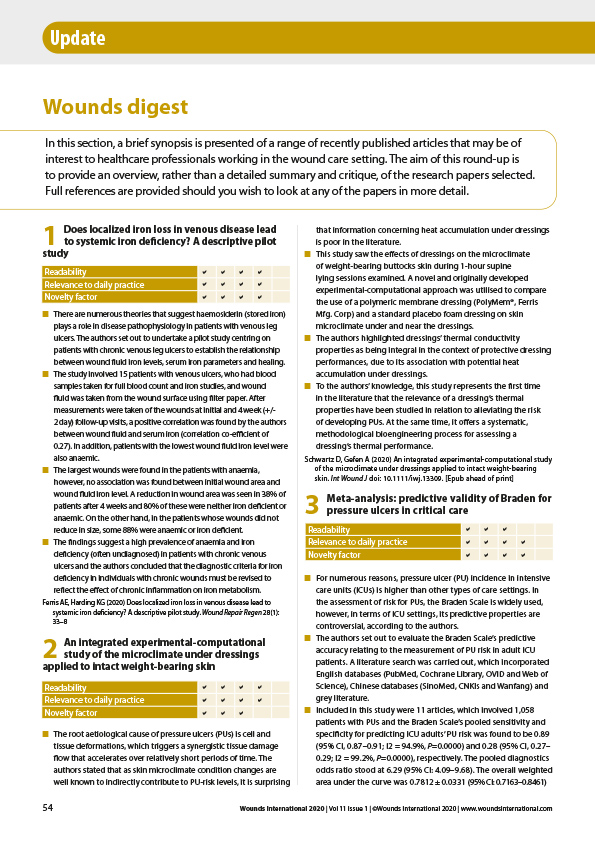
In this section, a brief synopsis is presented of a range of recently published articles that may be of interest to healthcare professionals working in the wound care setting. The aim of this round-up is to provide an overview, rather than a detailed summary and critique, of the research papers selected. Full references are provided […]
Retrospective chronic and postsurgical wound case series: Understanding RENASYS™ TOUCH
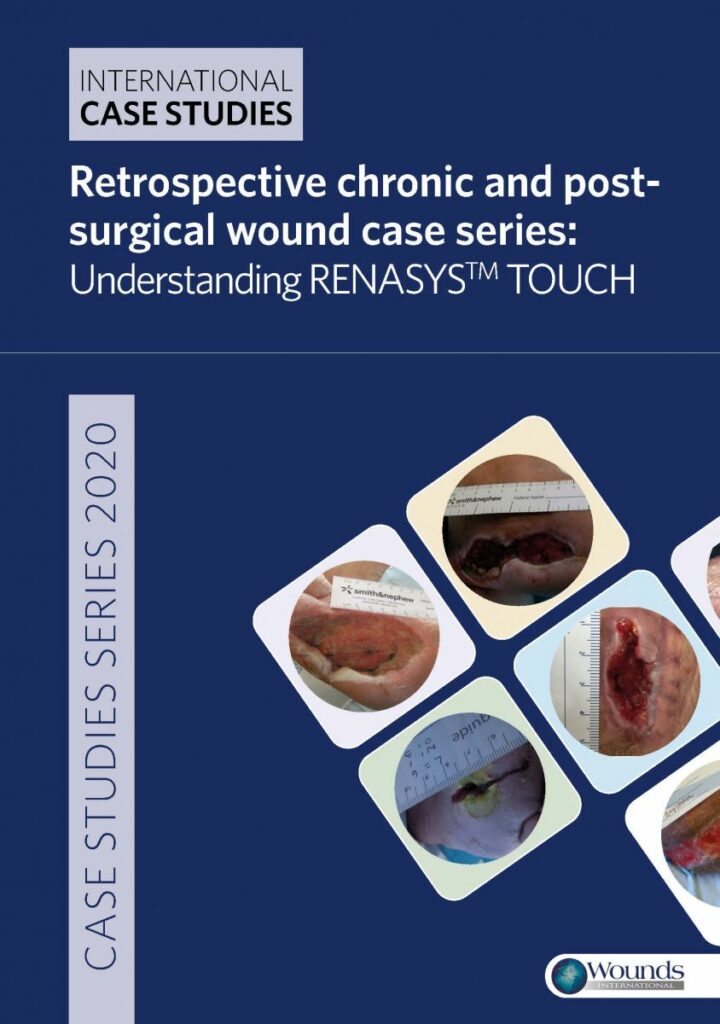
Negative pressure wound therapy (NPWT) in its modern form has been shown to be effective in the management of chronic and surgical wounds (Vig et al, 2011; Krug et al, 2011). The technology of NPWT devices has evolved continuously since its first inception. Early pumps were very basic in terms of their functionality and as […]
Ten top tips: wound cleansing
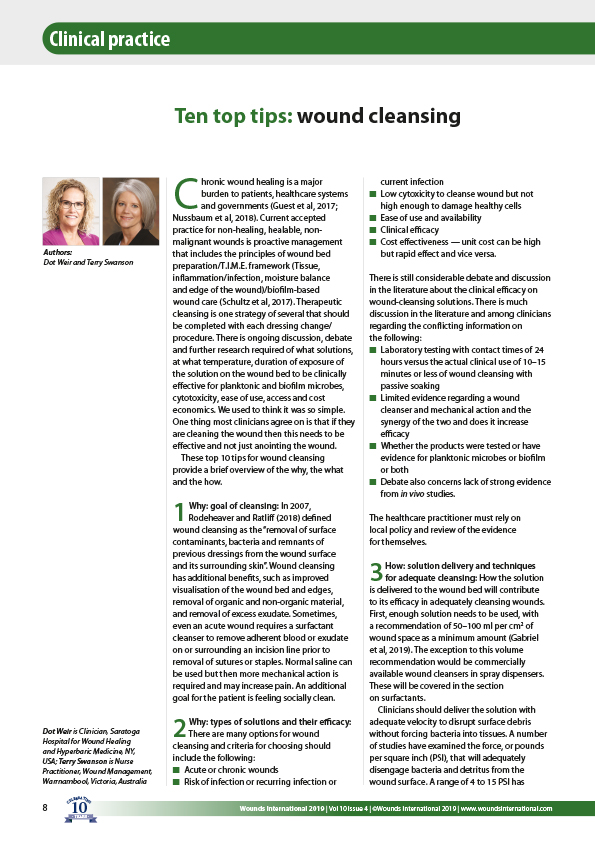
Chronic wound healing is a major burden to patients, healthcare systems and governments (Guest et al, 2017; Nussbaum et al, 2018). Current accepted practice for non-healing, healable, nonmalignant wounds is proactive management that includes the principles of wound bed preparation/T.I.M.E. framework (Tissue, inflammation/infection, moisture balance and edge of the wound)/biofilm-based wound care (Schultz et al, […]
Personality and wellbeing in people living with a chronic wounds
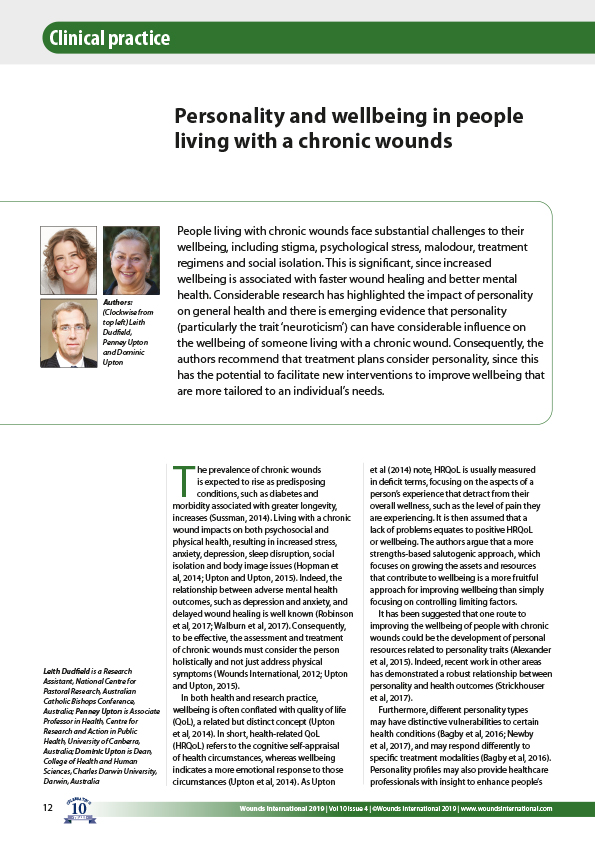
People living with chronic wounds face substantial challenges to their wellbeing, including stigma, psychological stress, malodour, treatment regimens and social isolation. This is significant, since increased wellbeing is associated with faster wound healing and better mental health. Considerable research has highlighted the impact of personality on general health and there is emerging evidence that personality […]
Wound microbiome update: sequencing and behaviour
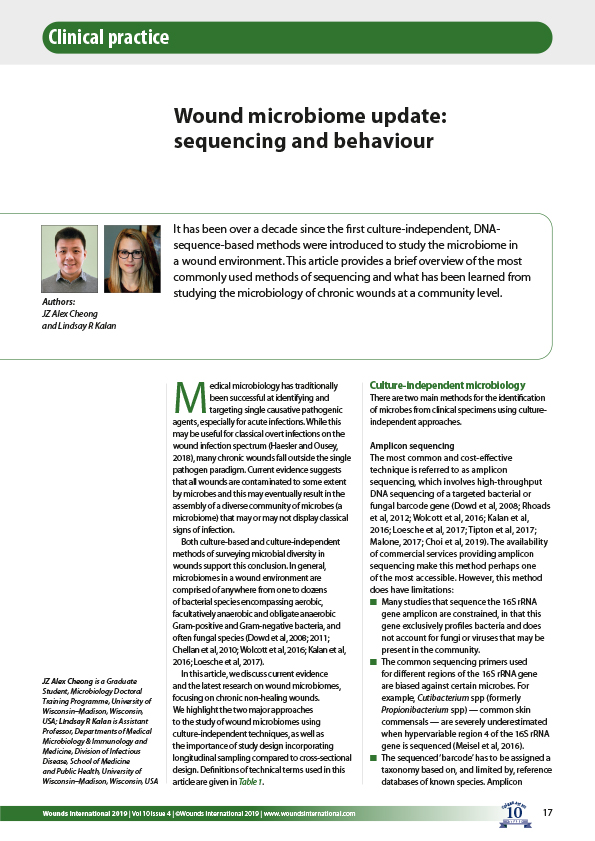
It has been over a decade since the first culture-independent, DNAsequence- based methods were introduced to study the microbiome in a wound environment. This article provides a brief overview of the most commonly used methods of sequencing and what has been learned from studying the microbiology of chronic wounds at a community level
Identifying and treating necrotising fasciitis: a clinical challenge
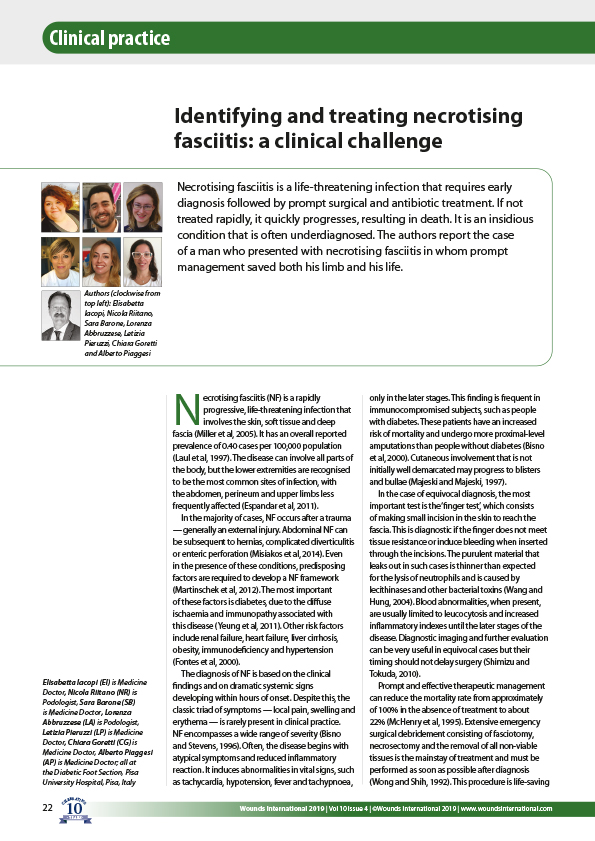
Necrotising fasciitis is a life-threatening infection that requires early diagnosis followed by prompt surgical and antibiotic treatment. If not treated rapidly, it quickly progresses, resulting in death. It is an insidious condition that is often underdiagnosed. The authors report the case of a man who presented with necrotising fasciitis in whom prompt management saved both […]
Potential of cold atmospheric pressure plasma (CAPP) in wound management
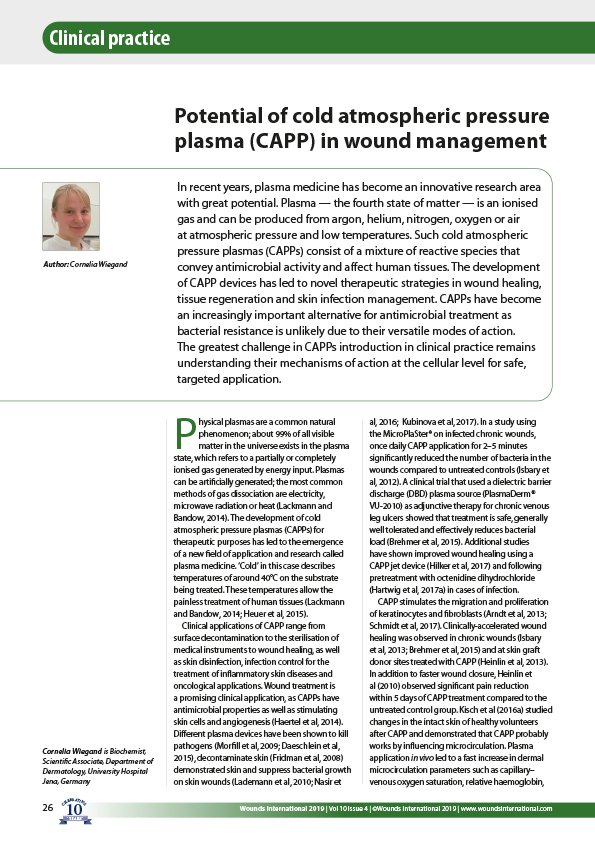
In recent years, plasma medicine has become an innovative research area with great potential. Plasma — the fourth state of matter — is an ionised gas and can be produced from argon, helium, nitrogen, oxygen or air at atmospheric pressure and low temperatures. Such cold atmospheric pressure plasmas (CAPPs) consist of a mixture of reactive […]
Using the new T.I.M.E. Clinical Decision Support Tool to promote consistent holistic wound management and eliminate variation in practice: Part 4 at Silver Chain Group, Perth, Australia
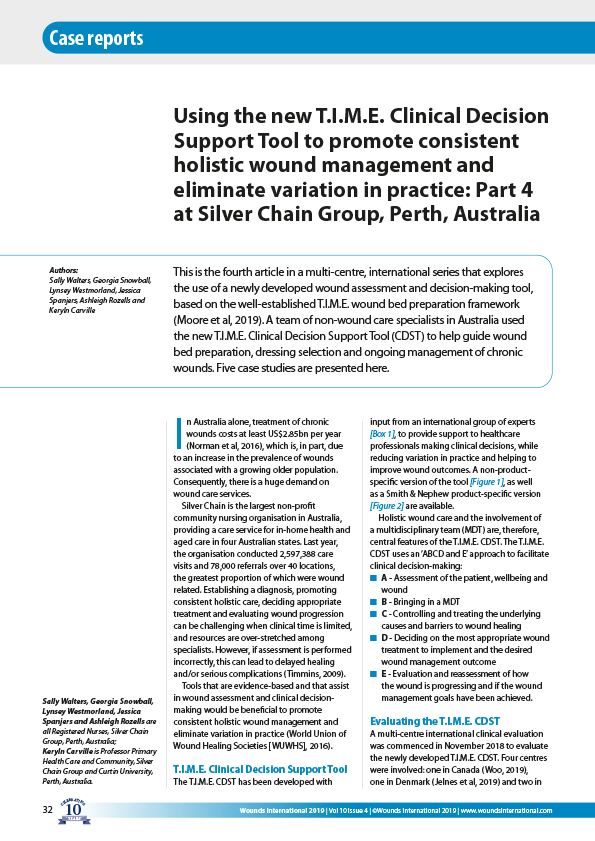
This is the fourth article in a multi-centre, international series that explores the use of a newly developed wound assessment and decision-making tool, based on the well-established T.I.M.E. wound bed preparation framework (Moore et al, 2019). A team of non-wound care specialists in Australia used the new T.I.M.E. Clinical Decision Support Tool (CDST) to help […]
Using the new T.I.M.E. Clinical Decision Support Tool to promote consistent holistic wound management and eliminate variation in practice: Part 5, survey feedback from non-specialists
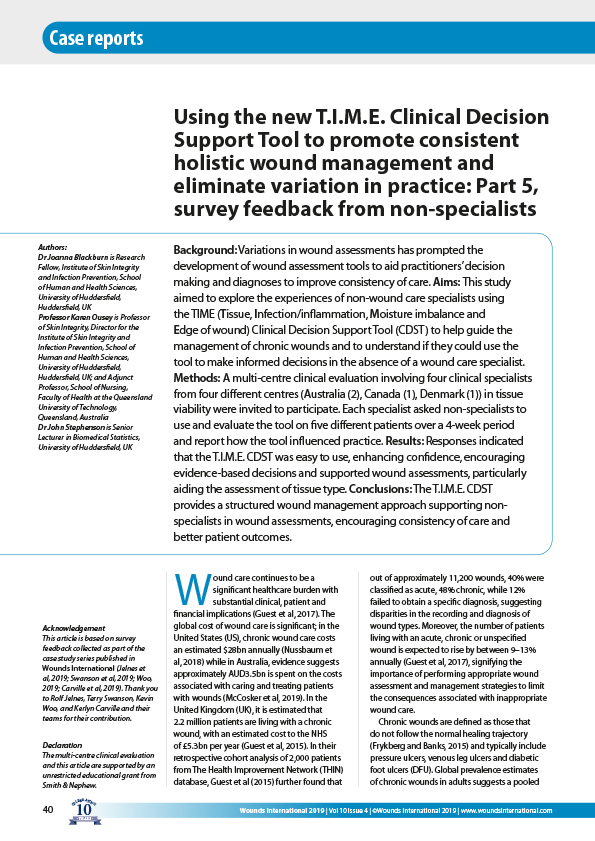
Background: Variations in wound assessments has prompted the development of wound assessment tools to aid practitioners’ decision making and diagnoses to improve consistency of care. Aims: This study aimed to explore the experiences of non-wound care specialists using the TIME (Tissue, Infection/inflammation, Moisture imbalance and Edge of wound) Clinical Decision Support Tool (CDST) to help […]
Supplementary oxygen and wound healing
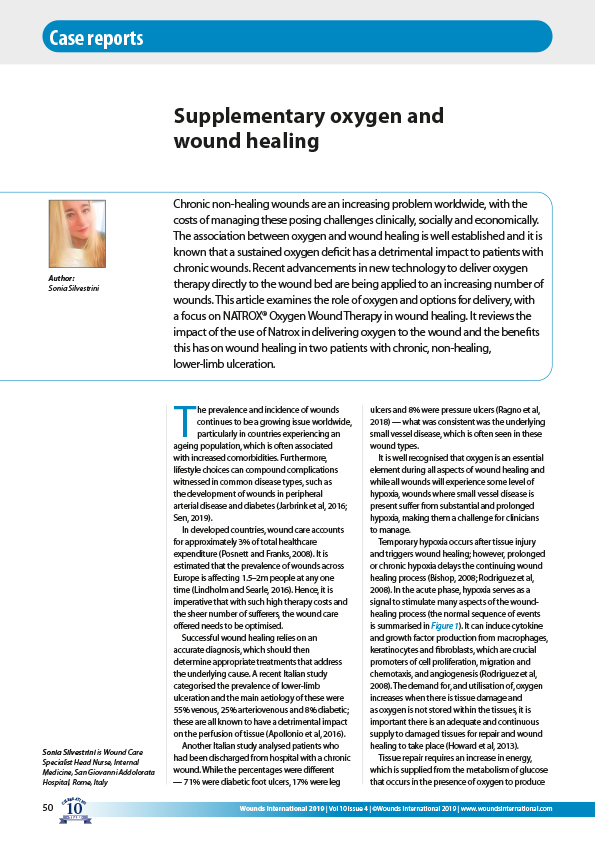
Chronic non-healing wounds are an increasing problem worldwide, with the costs of managing these posing challenges clinically, socially and economically. The association between oxygen and wound healing is well established and it is known that a sustained oxygen deficit has a detrimental impact to patients with chronic wounds. Recent advancements in new technology to deliver […]
Use of the PICO™ single use NPWT system in the prevention of surgical site infections
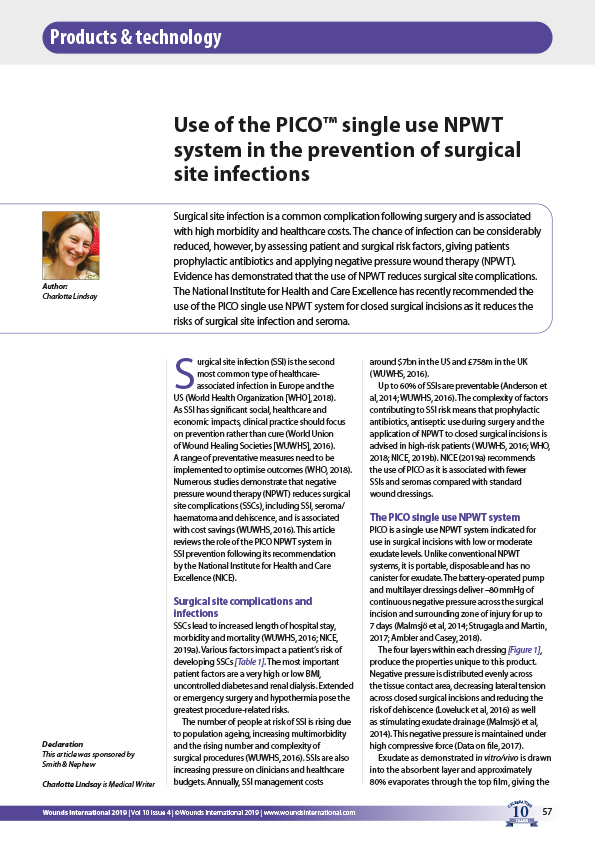
Surgical site infection is a common complication following surgery and is associated with high morbidity and healthcare costs. The chance of infection can be considerably reduced, however, by assessing patient and surgical risk factors, giving patients prophylactic antibiotics and applying negative pressure wound therapy (NPWT). Evidence has demonstrated that the use of NPWT reduces surgical […]
Use of the PICO™ single use NPWT system in the prevention of surgical site infections

Surgical site infection is a common complication following surgery and is associated with high morbidity and healthcare costs. The chance of infection can be considerably reduced, however, by assessing patient and surgical risk factors, giving patients prophylactic antibiotics and applying negative pressure wound therapy (NPWT). Evidence has demonstrated that the use of NPWT reduces surgical […]
Use of the PICO™ single use NPWT system in the prevention of surgical site infections

Surgical site infection is a common complication following surgery and is associated with high morbidity and healthcare costs. The chance of infection can be considerably reduced, however, by assessing patient and surgical risk factors, giving patients prophylactic antibiotics and applying negative pressure wound therapy (NPWT). Evidence has demonstrated that the use of NPWT reduces surgical […]
Investigation and review on the efficacy of super-oxidized solution (HYDROCYN aqua®) against biofilm
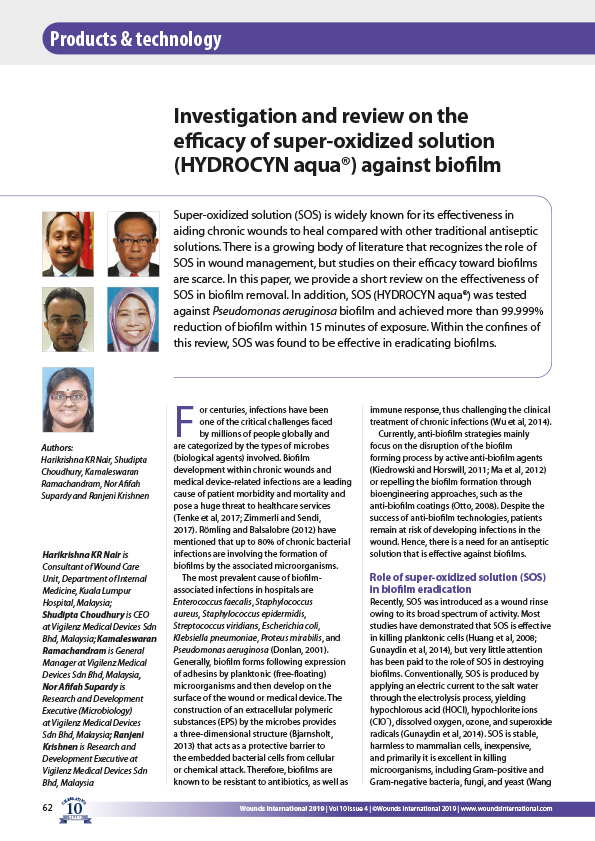
Super-oxidized solution (SOS) is widely known for its effectiveness in aiding chronic wounds to heal compared with other traditional antiseptic solutions. There is a growing body of literature that recognizes the role of SOS in wound management, but studies on their efficacy toward biofilms are scarce. In this paper, we provide a short review on […]
Conference Report: LINK for Wound Healing Congress
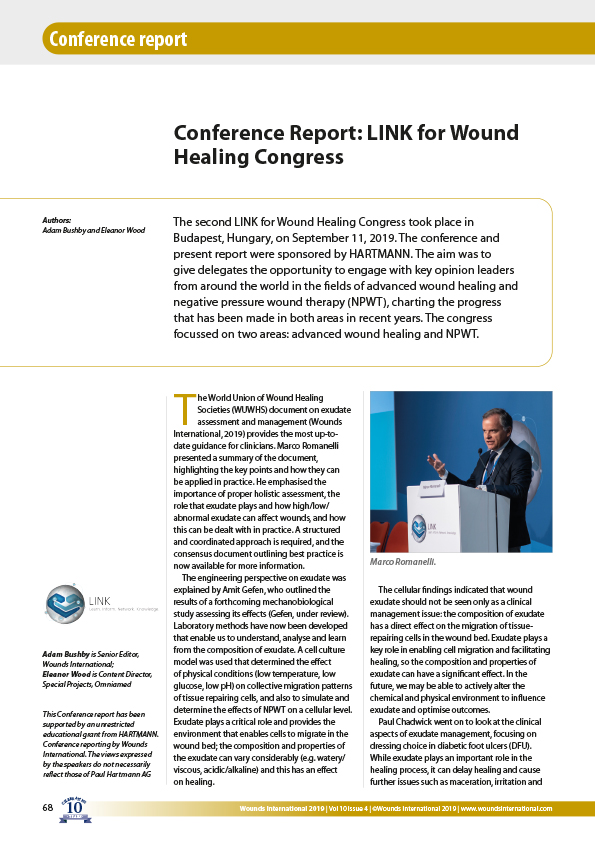
The second LINK for Wound Healing Congress took place in Budapest, Hungary, on September 11, 2019. The conference and present report were sponsored by HARTMANN. The aim was to give delegates the opportunity to engage with key opinion leaders from around the world in the fields of advanced wound healing and negative pressure wound therapy […]
Optimising the use of traditional NPWT in plastic and reconstructive surgery
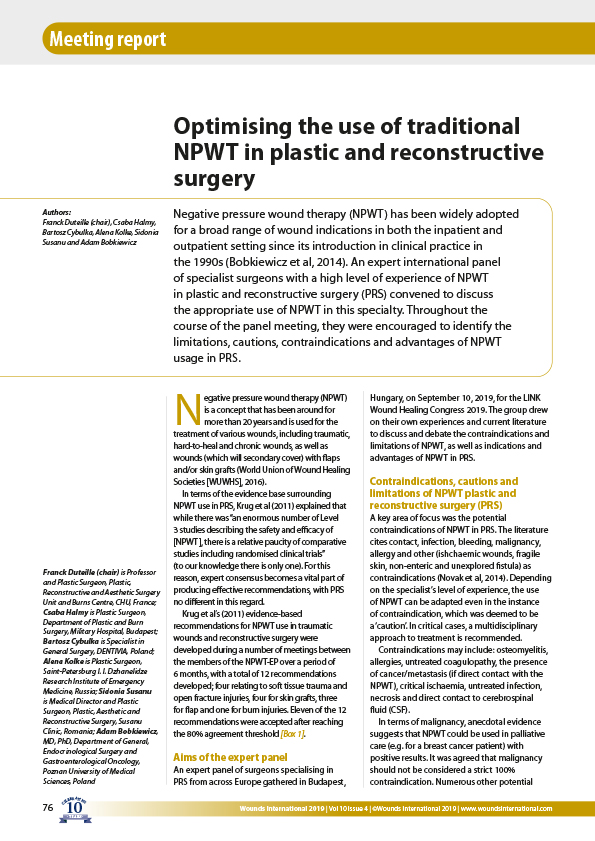
Negative pressure wound therapy (NPWT) has been widely adopted for a broad range of wound indications in both the inpatient and outpatient setting since its introduction in clinical practice in the 1990s (Bobkiewicz et al, 2014). An expert international panel of specialist surgeons with a high level of experience of NPWT in plastic and reconstructive […]


